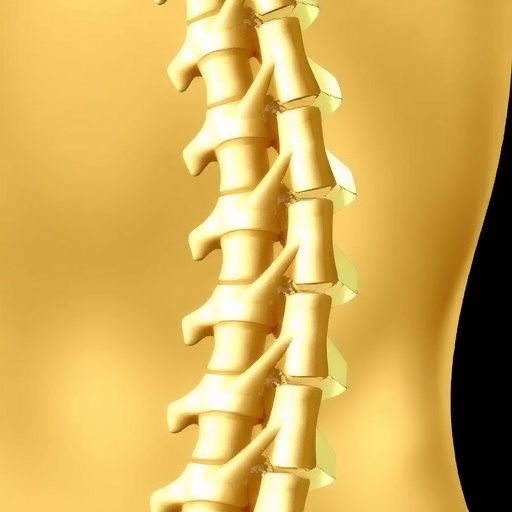
The intricate interplay between spinal bridging ossification and its implications on biomechanical properties has become a focal point of recent research. In a groundbreaking study, researchers have explored how these ossification changes influence the mechanical properties and fracture tolerance of spinal structures under flexion and extension loading. This study delves into the nuances of spinal health, potentially affecting treatment paths and outcomes for patients suffering from various spinal conditions.
The research introduces the concept of spinal bridging ossification, a phenomenon characterized by the formation of bony bridges connecting adjacent vertebrae. This development often leads to a reduction in the range of motion and can cause significant mechanical changes to the spine. Understanding how these ossifications alter mechanical properties is crucial, particularly in the context of injuries and degenerative diseases. The implications of such ossification on fracture tolerance are particularly pertinent in evaluating the risk that patients face during everyday activities.
When subjected to flexion and extension loading, the spine’s ability to withstand such forces is paramount. The study reveals that regions affected by spinal bridging ossification exhibit altered responses to mechanical stress. The findings suggest that these ossifications not only limit mobility but also weaken the overall structural integrity of the vertebral segments. This is highly significant, as many clinical interventions rely on restoring movement and ensuring the spine can absorb and dissipate forces without failure.
At the core of this research is a meticulous analysis of how bridging ossification influences the material properties of spinal tissues. The bones and cartilage that make up the spine are not just passive structures; they interact dynamically with applied loads. The study employs advanced biomechanical testing methods to provide insight into how these structures behave under stress. By analyzing factors such as stiffness, yield strength, and fracture toughness, the researchers aim to paint a comprehensive picture of how ossification alters mechanical performance.
As the research unfolds, it highlights the critical nature of understanding the loading conditions specific to the spine. Flexion and extension represent common movements in daily life, yet the effects of ossification during these movements have been inadequately documented. By simulating realistic loading scenarios, the study offers a clearer perspective on how patients might be affected by their condition. It underscores the importance of personalized assessments in managing spinal health, particularly for those with noticeable ossification.
The potential for enhanced fracture risk associated with spinal bridging ossification raises several clinical considerations. Given the aging population and the associated increase in conditions such as osteoarthritis and spinal stenosis, this research draws attention to the need for preventive strategies. Healthcare providers may need to adopt a more proactive approach in monitoring patients with ossification, especially those demonstrating reduced mobility. This could involve regular mechanical assessments and tailored therapeutic interventions aimed at improving spinal resilience.
In parallel, the study emphasizes the significance of interdisciplinary collaboration among biomedicine, engineering, and clinical practice. The integration of biomechanical analysis with clinical observations will pave the way for innovative treatments and rehabilitation protocols. Such collaboration can help in the development of assistive devices or surgical interventions that account for the mechanical limitations imposed by bridging ossification, ultimately enhancing patient outcomes.
Furthermore, this research contributes to the broader discourse surrounding spinal health. By elucidating the mechanical implications of ossification, the authors advocate for greater awareness of how degenerative changes can impact quality of life. Educational initiatives targeting both patients and healthcare practitioners could foster a culture of diligence in spinal health maintenance. It may also encourage preventive measures to maintain flexibility and reduce the likelihood of fractures.
Highlighting the intricate relationship between mechanical properties and fracture tolerance, the study sets a foundation for further exploration into non-invasive evaluation methods. Advanced imaging techniques could facilitate a better understanding of ossification’s extent and its implications on the surrounding tissues. This would enable caregivers to identify at-risk individuals and tailor rehabilitation programs that consider each patient’s unique structural changes.
Engaging the public in discussions about spinal health is equally important. Heightened awareness of conditions such as spinal bridging ossification can empower individuals to seek care sooner, thus mitigating potential complications. Furthermore, emphasizing the biomechanical aspects of spinal health can lead to better lifestyle choices, targeting physical activities that support musculoskeletal health while avoiding those that pose undue risk.
The implications of this study extend beyond immediate clinical applications; they touch on long-term health outcomes for individuals with spinal conditions. As research in this field progresses, the hope is to refine surgical techniques and develop biomimetic materials that can restore or enhance the mechanical properties of compromised tissues. The focus on maintaining or restoring spine flexibility could significantly impact how individuals manage their spinal health throughout their lives.
In conclusion, the research led by van Roden et al. is a significant contribution to the understanding of spinal bridging ossification and its mechanical implications. The study’s focus on biomechanical testing under relevant loading conditions illuminates the challenges faced by patients with this condition. It underscores the need for an integrative approach in clinical practice that unites research findings with patient care strategies. With ongoing advancements in this area, there is optimism for improved treatment modalities that prioritize the preservation of spinal health and the prevention of fractures.
The dialogue initiated by this research opens the door for future investigations, revealing a path toward a deeper understanding of spinal biomechanics and the multifaceted nature of ossification. By continuing to explore these dynamics, the biomedical community can strive toward establishing best practices that enhance the lives of those affected by spinal disorders. The significance of spinal health in overall well-being cannot be overstated, and ongoing research in this domain promises to yield innovations that resonate through the corridors of clinical practice for years to come.
Subject of Research: Influence of spinal bridging ossification on mechanical properties and fracture tolerance
Article Title: Influence of Spinal Bridging Ossification on Mechanical Properties and Fracture Tolerance Under Flexion/Extension Loading
Article References:
van Roden, E.A.R., Riggin, C.N., Holyoak, D.T. et al. Influence of Spinal Bridging Ossification on Mechanical Properties and Fracture Tolerance Under Flexion/Extension Loading.
Ann Biomed Eng (2025). https://doi.org/10.1007/s10439-025-03790-3
Image Credits: AI Generated
DOI:
Keywords: spinal bridging ossification, mechanical properties, fracture tolerance, flexion/extension loading, spinal health, biomechanical testing, interdisciplinary collaboration, preventive strategies.
Tags: biomechanical properties of spinal structuresdegenerative diseases of the spineflexion and extension loading in spinefracture tolerance in spinal healthimpact of ossification on range of motionimplications of spinal ossificationmechanical properties of the spinemechanical stress responses in spinal conditionsspinal bridging ossificationspinal health and injuriesstructural integrity of vertebraetreatment outcomes for spinal conditions




